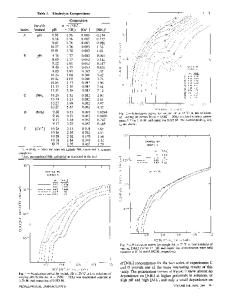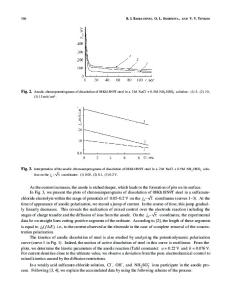Passive and transpassive anodic behavior of chalcopyrite in acid solutions
- PDF / 861,269 Bytes
- 9 Pages / 597.28 x 785 pts Page_size
- 99 Downloads / 308 Views
I.
INTRODUCTION
MUCH of the recent work on the hydrometallurgical processing of minerals has focused on the electrochemistry of the substances involved. ~-~2Chalcopyrite is important in this regard since it is a major copper mineral. The intrinsic anodic and cathodic electrochemical behavior of CuFeS2 has been demonstrated in several studies. 6-12 This ability to be either reduced or oxidized is a direct result of the thermodynamic properties of the mineral, the properties of the electrolyte used, and their interaction at the mineral semiconductor-electrolyte interface. Several researchers 3'13-1s have reported the oxidation of chalcopyrite by ferric sulfate to be represented stoichiometrically by the reaction CuFeS2 + 4Fe §
Cu § + 5Fe +2 + 2S ~
This overall leaching reaction may be expressed in terms of two half-cell reactions. Anodic: Cathodic:
CuFeS2 ~ Cu +2 + Fe § + 2S ~ + 4e4e- + 4Fe +3 ~ 4Fe +2
Various rate limiting steps, both surface reaction and transport processes, have been proposed. A synopsis of data given by the literature may be found in the paper by Munoz, et a1.3 These researchers presented a model derived from the Wagner theory of oxidation which implies that a protective sulfur layer is formed during the oxidation of chalcopyrite at 90 ~ with the rate limited by the transport of electrons through the insulating layer. A significant amount of the sulfur may be oxidized to sulfate but no mechanism has been presented which quantifies the amount of each found. 9'16'17
An insulating sulfur layer does not always form, for example, at low temperatures. In such cases the rate limiting step seems to be surface reaction or diffusion through intermediate passive sulfide layers. 8,9.16Jones16 carried out potentiostatic experiments in which he demonstrated the decrease in the current with time at low constant potentials. Warren 6 and Biegler and Swift 17 presented similar decay curves and demonstrated that the passive nature of the films formed diminished as the potential was increased. The apparent anomalies in the behavior of chalcopyrite are most likely the result of inherent physical and chemical differences of the mineral from different sources. The variations in electrical resistivity noted by Shuey could be due to variations in the mineral stoichiometry or impurities. ~s'J9 Linge has reported different leaching rates for different chalcopyrite specimens.2~ On the other hand, Biegler and Swift 17 anodically examined chalcopyrite of four origins at 1.13 V vs SCE in 1 M H2504 and concluded that the source of the mineral has little effect on the rate of chalcopyrite dissolution, at least at such high potentials. Prosser, 2t however, noted that the reactivity of chalcopyrite is dependent on grain size, crystal structure, porosity, and pre-history of a specific sample. The purpose of this study was: (1) to compare the behavior of several chalcopyrite samples from different sources in a single electrolyte; (2) to examine the behavior of one source of natural chalcopyrite (Transvaal) in detail in variou
Data Loading...











